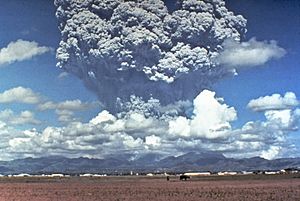History of the Philippines (1986–present) facts for kids
Quick facts for kids
Republic of the Philippines
Republika ng Pilipinas
|
|||||||
|---|---|---|---|---|---|---|---|
|
|
|||||||
|
Motto: "Maka-Diyos, Maka-Tao, Makakalikasan at Makabansa"
("For God, People, Nature, and Country")
|
|||||||
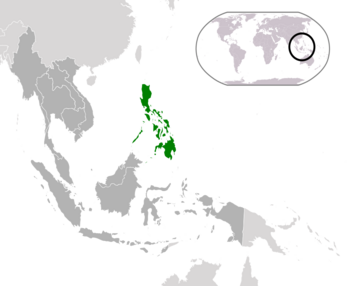
Location of the Philippines – green
in ASEAN – gray |
|||||||
| Capital | Manila 14°35′N 120°58′E / 14.583°N 120.967°E |
||||||
| Official languages |
|
||||||
| Government | Unitary presidential democratic constitutional republic | ||||||
| Bongbong Marcos | |||||||
| Sara Duterte | |||||||
|
• Senate President
|
Francis Escudero | ||||||
| Legislature | Congress | ||||||
| Senate | |||||||
| House of Representatives | |||||||
| Establishment | |||||||
|
• Current constitution
|
February 2, 1987 (38 years ago) | ||||||
| Area | |||||||
|
• Total
|
300,000 km2 (120,000 sq mi) | ||||||
| GDP (PPP) | • Total
Increase $1.0 trillion[10] (29th) • Per capita Increase $9,061 estimate |
||||||
|
• Total
|
• Total Increase $1.0 trillion[10] (29th? | ||||||
|
• Per capita
|
• Per capita Increase $9,061[10] (115th) | ||||||
| HDI (2019) | 0.718 high |
||||||
| Currency | Peso (Filipino: piso) (₱) (PHP) | ||||||
| ISO 3166 code | PH | ||||||
|
|||||||
The Fifth Philippine Republic is the current government of the Philippines. It began after the People Power Revolution in 1986. This event brought back democracy to the country.
Since 1986, the Philippines has worked to improve its government. However, it has faced challenges like national debt and political issues. There have also been natural disasters and conflicts with rebel groups. During this time, U.S. military forces left the Philippines. This happened after a treaty to extend their stay was not approved.
The country's economy has grown steadily over the years. Peace agreements have been made with some groups. However, other conflicts and economic challenges, like the 1997 Asian financial crisis, have also occurred. Recent presidents have focused on fighting crime, improving infrastructure, and making education and healthcare more accessible.
Contents
- Corazon Aquino's Time as President (1986–1992)
- Fidel Ramos's Time as President (1992–1998)
- Joseph Estrada's Time as President (1998–2001)
- Gloria Macapagal Arroyo's Time as President (2001–2010)
- Benigno Aquino III's Time as President (2010–2016)
- Rodrigo Duterte's Time as President (2016–2022)
- Bongbong Marcos's Time as President (2022–Present)
- See also
Corazon Aquino's Time as President (1986–1992)

After the People Power Revolution, Corazon Aquino became president. This marked the return of democracy to the Philippines. She quickly set up a new government. She also created a temporary "Freedom Constitution." This constitution brought back people's rights and changed the old government system.
A new, permanent constitution was written and approved in 1987. This new constitution limited the president's power to declare martial law. It also suggested creating special regions for certain areas. The constitution brought back the presidential system and a two-house Congress.
While democracy grew, Aquino's government faced challenges. There were several attempts by parts of the military to overthrow the government. These attempts made it hard for the country to become fully stable and grow its economy. Aquino also sold many government-owned services, like water and electricity.
Natural disasters also affected the economy. In June 1991, Mount Pinatubo erupted. It had been quiet for 600 years. This was the second-largest volcanic eruption of the 20th century. It caused many deaths and left thousands homeless. The eruption also made the global weather cooler for a while.
In September 1991, the Philippine Senate decided not to extend the stay of U.S. military bases. This happened despite President Aquino's efforts. The United States then handed over Clark Air Base in November 1991. They also gave back Subic Bay Naval Base in December 1992. This ended nearly a century of U.S. military presence in the Philippines.
Fidel Ramos's Time as President (1992–1998)
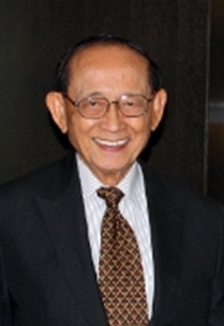
In the 1992 elections, Defense Secretary Fidel V. Ramos won the presidency. He was supported by Corazon Aquino. He won with a small percentage of the votes.
Early in his term, Ramos focused on "national reconciliation." This meant bringing different groups in the country together. He made the Communist Party legal again. He also started talks with communist rebels, Muslim separatists, and military rebels. In 1994, Ramos signed a law that offered amnesty to rebel groups. This helped end some conflicts. In 1995, an agreement was signed that ended the military rebellion.
In 1995, there was a disagreement with China. China built structures on Mischief Reef. This area in the Spratly Islands is also claimed by the Philippines.
Ramos faced some criticism for his economic policies. For example, a law that removed controls on oil prices led to higher gasoline costs. He was also criticized for alleged problems with money in some government deals.
A peace agreement was signed in 1996 with the Moro National Liberation Front (MNLF). This group was fighting for a separate homeland in Mindanao. This agreement ended their 24-year struggle. However, another group, the Moro Islamic Liberation Front (MILF), continued to fight for an Islamic state.
Joseph Estrada's Time as President (1998–2001)
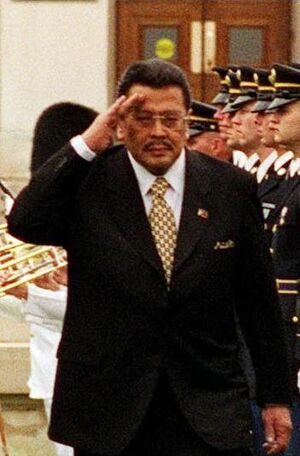
Joseph Estrada became president during the 1997 Asian Financial Crisis. However, the economy recovered during his term. Growth went from -0.6% in 1998 to 3.4% by 1999. He also tried to change parts of the 1987 Constitution. These changes aimed to attract more foreign investments. However, he was not successful in changing the constitution.
In March 2000, President Estrada declared "all-out-war" against the Moro Islamic Liberation Front (MILF). This was because of growing separatist movements in Mindanao. The government captured many MILF camps, including their main headquarters.
In October 2000, a close friend of Estrada accused him of receiving money from an illegal numbers game.
In November 2000, the House of Representatives began a process to remove Estrada from office. This was due to accusations of bribery and misuse of power. His trial in the Senate started in December. But it stopped in January 2001. This happened when senators allied with Estrada blocked the opening of bank records. These records were meant to show his involvement.
In response, many people gathered at the EDSA Shrine. This was the same place where Ferdinand Marcos was removed from power in 1986. They demanded Estrada's resignation. His cabinet members resigned, and the military and police withdrew their support. On January 20, the Supreme Court of the Philippines declared the presidency empty. They swore in Vice President Gloria Macapagal Arroyo as the new president. Estrada and his family left the Malacañan Palace.
Estrada later argued that he did not resign. But the Supreme Court confirmed Arroyo's legitimacy.
Gloria Macapagal Arroyo's Time as President (2001–2010)
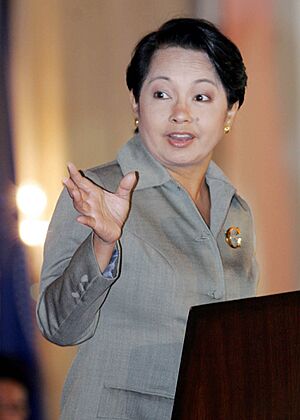
Gloria Macapagal Arroyo became president after Estrada's departure. Estrada challenged her legitimacy, but the Supreme Court upheld her position. After Estrada was arrested, some of his supporters tried to overthrow Arroyo's government. However, this attempt failed. Arroyo's power was further confirmed when her group won many seats in the 2001 elections.
Arroyo's first term had political challenges. There was a military uprising in Manila in July 2003. This led her to declare a state of rebellion for a month. She initially said she would not run in the 2004 presidential election. But she changed her mind and ran. She was re-elected and sworn in for her own six-year term in June 2004.
In 2005, a recording surfaced. It seemed to show Arroyo talking to an election official about her winning margin. This recording led to protests asking for her resignation. Arroyo admitted to speaking with an election official in an improper way. But she denied any fraud and refused to step down. Attempts to remove her from office failed that year.
Towards the end of her term, Arroyo pushed for a controversial plan. She wanted to change the constitution. The goal was to transform the government from a presidential system to a parliamentary one.
Benigno Aquino III's Time as President (2010–2016)
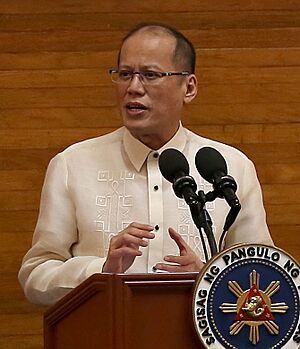
On June 9, 2010, Benigno Aquino III was declared the President-elect of the Philippines. This followed the 2010 election. Jejomar Binay was declared the Vice President-elect.
Aquino's team prepared for the change in leadership. They handled the new presidential residence and cabinet appointments. Aquino chose to live in Bahay Pangarap (House of Dreams). This was different from previous presidents. He felt the official palace was too big.
Aquino appointed many people to his cabinet. He named his long-time friend, Paquito Ochoa, Jr., as Executive Secretary. He also appointed a truth commission. This commission was set up to investigate various issues, including accusations against the outgoing President Gloria Macapagal Arroyo.
Aquino and Vice President Binay were sworn into office on June 30, 2010. The oath was given by Associate Justice Conchita Carpio-Morales. Aquino chose her instead of the Chief Justice. This was because he disagreed with the Chief Justice's appointment.
In 2013, the government announced new plans for peace talks. These talks were with the New People's Army.
In 2015, a clash happened in Mamasapano, Maguindanao. Forty-four members of the police special forces were killed. This event made it difficult to pass a new law for the Bangsamoro region.
Rodrigo Duterte's Time as President (2016–2022)

Rodrigo Duterte, the mayor of Davao City, won the 2016 presidential election by a large margin. He became the first president from Mindanao. Leni Robredo won as vice president.
Duterte's presidency began on June 30, 2016. On July 12, 2016, an international court ruled in favor of the Philippines. This was in a case against China's claims in the South China Sea.
In August 2016, the Duterte government launched a 24-hour complaint hotline, 8888. They also changed the national emergency number to 911.
In late 2016, President Duterte announced a shift in ties towards China and Russia. He also made strong statements about the United States and the United Nations.
In November 2016, the Supreme Court allowed the burial of former president Ferdinand Marcos in the country's heroes' cemetery. This caused protests from various groups.
Duterte started the "Build, Build, Build" program in 2017. This program aimed to improve the country's infrastructure. It included many projects for air, rail, and road transport. This program was expected to create more jobs and help the economy grow.
In 2017, Duterte signed a law for free tuition in public universities and colleges. He also signed 20 new laws. These included laws for universal health care and a national cancer control program. He also allowed people to keep their mobile numbers for life.
Duterte signed laws creating new government agencies. These included the Philippine Space Agency and departments for housing and migrant workers. He also started a national identification system. He made the adoption process simpler and launched a program to modernize public vehicles.
Duterte introduced economic changes to attract foreign investors. He reformed the country's tax system. He also took steps to fight problems with money and slow government processes. He aimed to make government information more accessible. In agriculture, he allowed more rice imports to stabilize prices. He also gave free irrigation to small farmers.
Duterte signed a law for free internet access in public places. He ensured all Filipinos were automatically covered by the government's health insurance. He also signed a mental health law and created "Malasakit Centers" in hospitals. He ordered the full use of the Reproductive Health Law. He banned smoking in public places nationwide and set price limits on certain medicines. He managed the country's response to the COVID-19 pandemic. This included strict lockdowns, which affected the economy. But the economy recovered with gradual reopening and a nationwide vaccination drive.
Duterte's approval ratings remained high during his presidency.
Bongbong Marcos's Time as President (2022–Present)
In May 2022, Bongbong Marcos, the son of former president Ferdinand Marcos, won the presidential election. His running mate for vice president was Sara Duterte, the daughter of then-president Rodrigo Duterte. On June 30, 2022, Marcos was sworn in as the Philippine president. Sara Duterte also took her oath as vice-president.
See also
- Timeline of Philippine history




